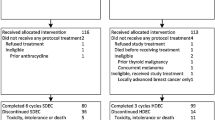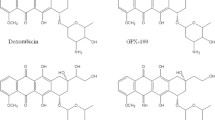Abstract
Cardiotoxicity caused by anthracyclines chemotherapy is one of the leading causes of mortality and morbidity in cancer survivors. Continuous infusion (CI) instead of bolus (BOL) injection is one of the methods that seem to be effective in reducing doxorubicin (DOX) cardiotoxicity. Due to the variety of results, we decided to compare these two approaches regarding toxicity and efficacy and report the final results for different cancers. We included 21 studies (four preclinical and seventeen clinical trials) up to May 15, 2023. In children with acute lymphoblastic leukemia (ALL) and adults with chronic lymphoblastic leukemia (CLL) and gastric cancer, results were in favor of BOL injection, without increase in cardiotoxicity. On the other hand, CI showed to be better option in patients with small-cell lung cancer (SCLC) and breast cancer. Various results were also observed in adult patients with sarcoma. Overall, it can be concluded that the benefits of CI, especially in adults, outweigh its disadvantages. However, due to the variety of results and heterogeneity of studies, further clinical trials with a larger sample size and a longer duration of follow-up are needed to make a more accurate comparison between CI and BOL injection.

Similar content being viewed by others
Data availability
Not applicable.
References
Anderson H, Hopwood P, Prendiville J, Radford JA, Thatcher N, Ashcroft L (1993) A randomised study of bolus vs continuous pump infusion of ifosfamide and doxorubicin with oral etoposide for small cell lung cancer. Br J Cancer 67(6):1385–1390
Anderson H, Prendiville J, Thatcher N, Radford JA, Swindell R (1991) A randomised study of intravenous bolus versus continuous infusion of ifosfamide and doxorubicin with oral etoposide for small-cell lung cancer. J Cancer Res Clin Oncol 117(Suppl 4):S139-140
Bielack SS, Erttmann R, Kempf-Bielack B, Winkler K (1996) Impact of scheduling on toxicity and clinical efficacy of doxorubicin: what do we know in the mid-nineties? Eur J Cancer 32a(10):1652–1660
Brown TR, Vijarnsorn C, Potts J, Milner R, Sandor GG, Fryer C (2013) Anthracycline induced cardiac toxicity in pediatric Ewing sarcoma: a longitudinal study. Pediatr Blood Cancer 60(5):842–848
Cardinale D, Colombo A, Lamantia G, Colombo N, Civelli M, De Giacomi G, Rubino M, Veglia F, Fiorentini C, Cipolla CM (2010) Anthracycline-induced cardiomyopathy: clinical relevance and response to pharmacologic therapy. J Am Coll Cardiol 55(3):213–220
Cardinale D, Sandri MT, Colombo A, Colombo N, Boeri M, Lamantia G, Civelli M, Peccatori F, Martinelli G, Fiorentini C, Cipolla CM (2004) Prognostic value of troponin I in cardiac risk stratification of cancer patients undergoing high-dose chemotherapy. Circulation 109(22):2749–2754
Cardinale D, Sandri MT, Martinoni A, Tricca A, Civelli M, Lamantia G, Cinieri S, Martinelli G, Cipolla CM, Fiorentini C (2000) Left ventricular dysfunction predicted by early troponin I release after high-dose chemotherapy. J Am Coll Cardiol 36(2):517–522
Casper ES, Gaynor JJ, Hajdu SI, Magill GB, Tan C, Friedrich C, Brennan MF (1991) A prospective randomized trial of adjuvant chemotherapy with bolus versus continuous infusion of doxorubicin in patients with high-grade extremity soft tissue sarcoma and an analysis of prognostic factors. Cancer 68(6):1221–1229
Chang HM, Moudgil R, Scarabelli T, Okwuosa TM, Yeh ETH (2017) Cardiovascular complications of cancer therapy: best practices in diagnosis, prevention, and management: part 1. J Am Coll Cardiol 70(20):2536–2551
Cranmer LD, Hess LM, Sugihara T, Muntz HG (2023) Cardiac events among patients with sarcoma treated with doxorubicin by method of infusion: a real-world database study. Cancer Rep (Hoboken) 6(1):e1681
Cusack BJ, Young SP, Driskell J, Olson RD (1993) Doxorubicin and doxorubicinol pharmacokinetics and tissue concentrations following bolus injection and continuous infusion of doxorubicin in the rabbit. Cancer Chemother Pharmacol 32(1):53–58
El-Kareh AW, Secomb TW (2000) A mathematical model for comparison of bolus injection, continuous infusion, and liposomal delivery of doxorubicin to tumor cells. Neoplasia 2(4):325–338
Gianni L, Herman EH, Lipshultz SE, Minotti G, Sarvazyan N, Sawyer DB (2008) Anthracycline cardiotoxicity: from bench to bedside. J Clin Oncol 26(22):3777–3784
Hortobagyi GN, Frye D, Buzdar AU, Ewer MS, Fraschini G, Hug V, Ames F, Montague E, Carrasco CH, Mackay B et al (1989) Decreased cardiac toxicity of doxorubicin administered by continuous intravenous infusion in combination chemotherapy for metastatic breast carcinoma. Cancer 63(1):37–45
Jasmin C, Gil-Delgado MA, Marino JP, Ecstein E, Descorps-Declere A, Misset JL (1990) Phase I-II constant infusion of adriamycin (doxorubicin) by ambulatory pump delivery system in heavily pretreated (including adriamycin) breast cancer patients. Ann Oncol 1(3):189–193
Kamendi H, Zhou Y, Crosby M, Keirstead N, Snow D, Bentley P, Patel N, Barthlow H, Luo W, Dragan Y, Bialecki R (2015) Doxorubicin: comparison between 3-h continuous and bolus intravenous administration paradigms on cardio-renal axis, mitochondrial sphingolipids and pathology. Toxicol Appl Pharmacol 289(3):560–572
Legha SS, Benjamin RS, Mackay B, Ewer M, Wallace S, Valdivieso M, Rasmussen SL, Blumenschein GR, Freireich EJ (1982) Reduction of doxorubicin cardiotoxicity by prolonged continuous intravenous infusion. Ann Intern Med 96(2):133–139
Li J, Chang HM, Banchs J, Araujo DM, Hassan SA, Wagar EA, Yeh ETH, Meng QH (2020) Detection of subclinical cardiotoxicity in sarcoma patients receiving continuous doxorubicin infusion or pre-treatment with dexrazoxane before bolus doxorubicin. Cardiooncology 6:1
Lipshultz SE, Giantris AL, Lipsitz SR, Kimball Dalton V, Asselin BL, Barr RD, Clavell LA, Hurwitz CA, Moghrabi A, Samson Y, Schorin MA, Gelber RD, Sallan SE, Colan SD (2002) Doxorubicin administration by continuous infusion is not cardioprotective: the Dana-Farber 91–01 Acute Lymphoblastic Leukemia protocol. J Clin Oncol 20(6):1677–1682
Lipshultz SE, Miller TL, Lipsitz SR, Neuberg DS, Dahlberg SE, Colan SD, Silverman LB, Henkel JM, Franco VI, Cushman LL, Asselin BL, Clavell LA, Athale U, Michon B, Laverdière C, Schorin MA, Larsen E, Usmani N, Sallan SE (2012) Continuous versus bolus infusion of doxorubicin in children with all: long-term cardiac outcomes. Pediatrics 130(6):1003–1011
Lokich J, Bothe A, Zipoli T, Green R, Sonneborn H, Paul S, Philips D (1983) Constant infusion schedule for adriamycin: a phase I-II clinical trial of a 30-day schedule by ambulatory pump delivery system. J Clin Oncol 1(1):24–28
Lum BL, Svec JM, Torti FM (1985) Doxorubicin: alteration of dose scheduling as a means of reducing cardiotoxicity. Drug Intell Clin Pharm 19(4):259–264
Minotti G, Menna P, Salvatorelli E, Cairo G, Gianni L (2004) Anthracyclines: molecular advances and pharmacologic developments in antitumor activity and cardiotoxicity. Pharmacol Rev 56(2):185–229
Mishra SS, Senapati SB, Dhir MK, Das S, Burma S (2013) A case of primary skull lymphoma: review of literature. Neurol India 61(3):334–336
Muller C, Chatelut E, Gualano V, De Forni M, Huguet F, Attal M, Canal P, Laurent G (1993) Cellular pharmacokinetics of doxorubicin in patients with chronic lymphocytic leukemia: comparison of bolus administration and continuous infusion. Cancer Chemother Pharmacol 32(5):379–384
Popov I, Jelić S, Radulović S, Radosavljević D, Nikolić-Tomašević Z (2000) Eight-hour infusion versus bolus injection of doxorubicin in the EAP regimen in patients with advanced gastric cancer: A prospective randomised trial. Ann Oncol 11(3):343–348
Seymour L, Bramwell V, Moran LA (1999) Use of dexrazoxane as a cardioprotectant in patients receiving doxorubicin or epirubicin chemotherapy for the treatment of cancer. The Provincial Systemic Treatment Disease Site Group. Cancer Prev Control 3(2):145–159
Shapira J, Gotfried M, Lishner M, Ravid M (1990) Reduced cardiotoxicity of doxorubicin by a 6-hour infusion regimen. A prospective randomized evaluation. Cancer 65(4):870–873
Siebel C, Würthwein G, Lanvers-Kaminsky C, André N, Berthold F, Castelli I, Chastagner P, Doz F, English M, Escherich G, Frühwald MC, Graf N, Groll AH, Ruggiero A, Hempel G, Boos J (2020) Can we optimise doxorubicin treatment regimens for children with cancer? Pharmacokinetic simulations and a Delphi consensus procedure. BMC Pharmacol Toxicol 21(1):37
Speyer JL, Green MD, Dubin N, Blum RH, Wernz JC, Roses D, Sanger J, Muggia FM (1985) Prospective evaluation of cardiotoxicity during a six-hour doxorubicin infusion regimen in women with adenocarcinoma of the breast. Am J Med 78(4):555–563
Storm G, van Hoesel QG, de Groot G, Kop W, Steerenberg PA, Hillen FC (1989) A comparative study on the antitumor effect, cardiotoxicity and nephrotoxicity of doxorubicin given as a bolus, continuous infusion or entrapped in liposomes in the Lou/M Wsl rat. Cancer Chemother Pharmacol 24(6):341–348
Swain SM (1998) Adult multicenter trials using dexrazoxane to protect against cardiac toxicity. Semin Oncol 25(4 Suppl 10):43–47
Sweatman TW, Lokich JJ, Israel M (1989) Clinical pharmacology of continuous infusion doxorubicin. Ther Drug Monit 11(1):3–9
Twelves CJ, Dobbs NA, Aldhous M, Harper PG, Rubens RD, Richards MA (1991) Comparative pharmacokinetics of doxorubicin given by three different schedules with equal dose intensity in patients with breast cancer. Cancer Chemother Pharmacol 28(4):302–307
van Dalen EC, Raphaël MF, Caron HN, Kremer LC (2014) Treatment including anthracyclines versus treatment not including anthracyclines for childhood cancer. Cochrane Database Syst Rev(9): Cd006647
Vejpongsa P, Yeh ET (2014) Prevention of anthracycline-induced cardiotoxicity: challenges and opportunities. J Am Coll Cardiol 64(9):938–945
Walczak BE, Irwin RB (2013) Sarcoma chemotherapy. J Am Acad Orthop Surg 21(8):480–491
Zalupski M, Metch B, Balcerzak S, Fletcher WS, Chapman R, Bonnet JD, Weiss GR, Ryan J, Benjamin RS, Baker LH (1991) Phase III comparison of doxorubicin and dacarbazine given by bolus versus infusion in patients with soft-tissue sarcomas: a Southwest Oncology Group study. J Natl Cancer Inst 83(13):926–932
Author information
Authors and Affiliations
Contributions
H.G. and N.O. wrote the main manuscript text and H.G prepared figures 1. All authors reviewed the manuscript. The authors confirm that no paper mill and artificial intelligence was used.
Corresponding authors
Ethics declarations
Competing interests
The authors declare no competing interests.
Ethical approval
Not applicable.
Additional information
Publisher's Note
Springer Nature remains neutral with regard to jurisdictional claims in published maps and institutional affiliations.
Rights and permissions
Springer Nature or its licensor (e.g. a society or other partner) holds exclusive rights to this article under a publishing agreement with the author(s) or other rightsholder(s); author self-archiving of the accepted manuscript version of this article is solely governed by the terms of such publishing agreement and applicable law.
About this article
Cite this article
Ghiami, H., Omidkhoda, N., Seddigh-Shamsi, M. et al. Comparison of bolus administration and short-term infusion versus long-term infusion of doxorubicin in terms of cardiotoxicity and efficacy. Naunyn-Schmiedeberg's Arch Pharmacol 397, 3771–3780 (2024). https://doi.org/10.1007/s00210-023-02886-8
Received:
Accepted:
Published:
Issue Date:
DOI: https://doi.org/10.1007/s00210-023-02886-8




